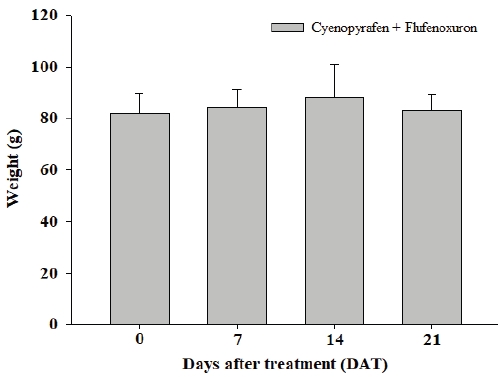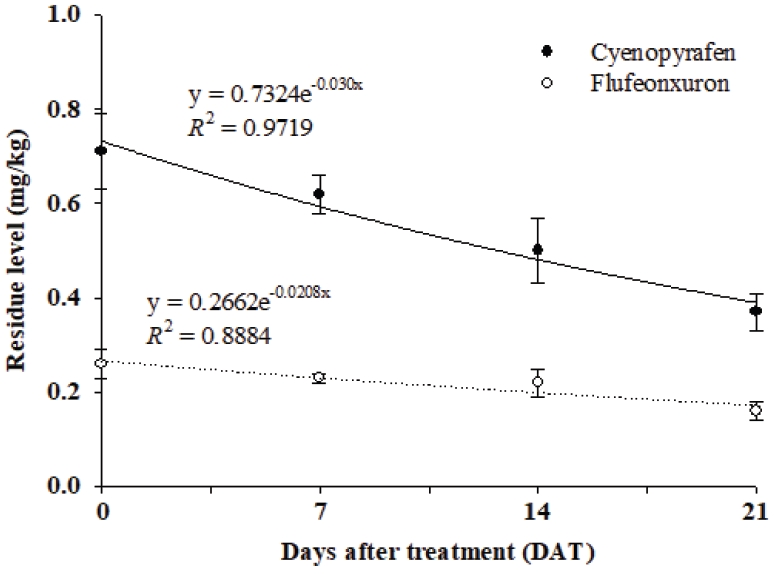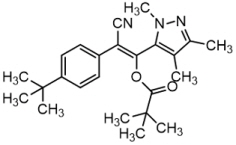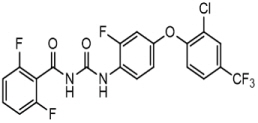
패션프루트 중 Cyenopyrafen과 Flufenoxuron 합제의 잔류 및 분포 특성
초록
본 연구는 패션프루트 중 살충제 cyenopyrafen와 flufenoxuron의 잔류 및 분포 특성을 평가하기 위하여 수행되었다. 농약은 7일 간격으로 패션프루트에 2회 살포하였으며, 최종 살포일로부터 0, 7, 14, 21일차에 시료를 수확하였다. 시험농약은 acetonitirile과 QuEChERS kit로 추출하고 d-SPE로 정제하여 LC-MS/MS로 분석하였다. 분석법상의 정량한계는 두 살충제 모두 0.01 mg/kg이었다. 회수율 시험은 0.01 mg/kg, 0.1 mg/kg 및 예상되는 잔류 수준으로 수행되었다. Cyenopyrafen의 회수율은 81.0~99.2%, flufenoxuron 회수율은 73.9~100.8%이었다. 농약 잔류량의 최대량은 0일차에서 0.80 mg/kg(cyenopyrafen), 0.29 mg/kg(flufenoxuron)이었다. 0일차에서 21일차까지의 소실율은 각각 47.9% 및 38.5%였다. 생물학적 반감기는 cyenopyrafen이 23.9일, flufenoxuron 35.0일이었다. 껍질에서의 농약 잔류량은 cyenopyrafen이 0.61±0.14 mg/kg, flufenoxuron 0.26±0.04 mg/kg이었다. 씨를 포함한 과육의 농약 잔류량은 cyenopyrafen이 0.01±0.00 mg/kg, flufenoxuron이 분석법상의 정량한계 미만이었다. 대부분의 농약 잔류량은 패션프루트의 표면에 남아있어 껍질을 벗기면 제거할 수 있다. 이는 껍질을 벗겨 섭취할 경우 농약 잔류로부터 안전함을 의미한다.
Abstract
This study was carried out to investigate residue and distribution of cyenopyrafen and flufenoxuron in passion fruit. Before harvest, the pesticides were sprayed onto the fruit twice at one-week intervals. Samples were then harvested at 0, 7, 14, 21 days after the final pesticide treatment (DAT). The insecticides were extracted utilizing acetonitrile and a QuEChERS kit, purified with d-SPE, and analyzed with LC-MS/MS. The method limit of quantitation (MLOQ) was 0.01 mg/kg for each pesticide tested. Recovery tests were conducted at levels of 0.01 mg/kg, 0.1 mg/kg, and residue level in sample. Recovery of cyenopyrafen residue was 81.0~99.2%; while recovery of flufenoxuron residue was 73.9~100.8%. At 0 DAT, maximum amounts of pesticides were 0.80 mg/kg (cyenopyrafen) and 0.29 mg/kg (flufenoxuron). Dissipation proportions were 47.9% and 38.5%, respectively, from 0 DAT to 21 DAT. Biological half-lives were 23.9 days for cyenopyrafen and 35.0 days for flufenoxuron, Pesticide residue in the peel at 21 DAT were 0.61 ± 0.14 mg/kg for cyenopyrafen and 0.26 ± 0.04 mg/kg for flufenoxuron, In the fruit pulp containing seeds, pesticide residues were MLOQ for cyenopyrafen and less than MLOQ for flufenoxuron. Most pesticide residue was localized on the surface of the passion fruit and was removed by peeling. This result indicates that passion fruit is safe to eat from pesticide residues after peeling.
Keywords:
Cyenopyrafen, Flufenoxuron, Passion fruit, Residue, Distribution pattern키워드:
패션프루트, 잔류특성, 분포양상서 론
아열대 과수 중 하나인 패션프루트 (Passion fruit)는 시계꽃과 (Passifloraceae)에 속하는 반목본성 다년생 덩굴식물로 브라질이 원산지이자 최대 생산국이며, 세계적으로 평균 140만 톤이 매년 생산되고 있다(Jeon et al.,2022; Jeong et al., 2022). 패션프루트는 산류, 당류, 영양성분 및 비영양성 식물화합물 등 여러가지 성분을 함유하고 있으며(Devi Ramaiya et al., 2013; Fonseca et al., 2022, RDA, 2022), 과즙에는 여러 당류, 비타민, 니아신, 칼륨, 카로틴, 향기성분(Whitfield and Sugowdz, 1979; Winterhalter, 1990), 종자에는 고농도의 리놀산 및 지질, 과피에는 상당량의 펙틴을 함유하고 있어 기능성 원료로써 식품개발에 활용되기도 한다(Kulkarni and Vijayanand, 2010; Liew et al., 2014; Lim and Cha, 2014; Silva et al., 2008).
우리나라에 패션프루트는 1989년 제주도 일부 농가에서 첫 도입 및 재배를 시작하여 2010년부터 담양 지역 등으로 재배가 확대되어 2015년 재배면적 7.3 ha에서 2021년 20.25 ha로 증가하였고, 농업경영체 수는 2015년 14호에서 2021년 94호로 매년 증가하고 있다(MAFRA, 2022). 하지만 국내에서 재배 면적과 재배 농가가 꾸준히 증가하고 있음에도 불구하고 패션프루트와 같은 소면적 재배 작물은 사용 등록된 농약이 없거나 부족한 실정이다(Ahn et al., 2014; Kang et al., 2018).
2019년 1월 1일 국내 유통되는 모든 농산물을 대상으로 잔류허용기준(MRL, Maximum Residue Limit)이 없는 농약과 미등록 농약에 대해 불검출 수준의 일률기준(0.01 mg/kg)을 적용하여 관리하는 허용물질목록관리제도(PLS, Positive List System)가 시행됨에 따라 농촌진흥청 및 식품의약품안전처에서는 소면적 재배 작물에 대한 농약의 확대등록을 위해 노력하고 있으나 발생 병해충의 다양화 및 이상기후 현상 등으로 농약 부족 문제가 계속적으로 대두되고 있다(Hwang et al., 2019). 2021년 기준 패션프루트에 등록된 농약 제품은 31개이나, 동일 성분을 제외할 경우 아족시스트로빈 21.7% 액상수화제 외 7 품목이며, 방제 대상은 잿빛곰팡이병, 역병, 파밤나방, 꽃노랑총채벌래, 톱다리개미허리노린재 등 5종에 불과하다 (RDA, 2021). 패션프루트에 발생하는 병해충은 이외에도 탄저병, 시들음병, 파리, 응애 및 진딧물 등 다양하게 보고되어 있으나(Aguiar-Menezes et al., 2002), 기등록 농약으로는 방제가 어려운 상황이다. 또한, 패션프루트에 잔류허용기준이 설정된 농약 29종 중 17종이 잠정잔류허용기준으로 PLS 시행 이후 유예기간인 2021년 12월 31일로 이런 잠정기준이 만료되었다.
Cyenopyrafen과 flufenoxuron 합제는 신규 계통 및 벤조일우레아계의 혼합살충제로 응애를 효과적으로 방제할 수 있는 약제로 (RDA, 2021), 잠정허용기준이 만료됨에 따라 MRL 설정 및 농약 등록을 위해 패션프루트에서의 잔류특성 연구가 필요한 실정이다.
패션프루트는 일반적으로 과피를 제거한 후 씨를 포함한 과육을 생과, 주스 혹은 잼으로 섭취하는데 (Kim, 2017), 농산업 폐기물로 버려지는 과피가 최근 기능성 성분을 포함하고 있어 다양한 식품산업에서 연구가 진행되고 있다 (Jeong, 2018; Perina et al., 2015).
따라서 본 연구를 통해 소면적 작물인 패션프루트를 대상으로 cyenopyrafen 및 flufenoxuron의 잔류 특성 및 과실 전과 (whole), 과육 및 과피 등 부위별 분포 특성을 구명하여 패션프루트에 적용 가능한 농약등록 확대 및 농약 안전성 확보를 위한 기초 자료로 활용하고자 하였다.
재료 및 방법
시약, 재료 및 기구
Cyenopyrafen (99.9%) 분석용 표준품은 Wako Pure Chemical Industry (Osaka, Japan)와 flufenoxuron (98.1%)의 Sigma-Aldrich (Saint Louid, USA)로부터 구입하여 사용하였으며, 본 연구에 이용된 두 약제의 물리 화학적 특성은 (Table 1)과 같다.
시료의 전처리 및 기기분석에는 acetonitrile은 Burdick & Jackson (Muskegon, MI, USA)의 HPLC급을 사용하였으며 acetic acid는 Samchun Chemical (99.7%, Seoul, Korea), formic acid (≥99.5%) 는 Sigma-Aldrich (Saint Louid, USA), d-SPE (PSA 25 mg, MgSO4 150 mg)는 Chromatific (Heidenrod, Germany), QuEChERS EN 15662 Method Extraction Kit (MgSO4 4.0 g, NaCl 1.0 g, sodium citrate tribasic dehydrate 1 g, sodium citrate dibasic sesquihydrate 0.5 g)와 roQ QuEChERS Extraction Kit (original, MgSO4 6.0 g, NaCl 1.5 g)는 Phenomenex (Torrance, CA, USA)에서 구매하여 사용하였고, 증류수는 Zeneer Power Ⅱ (Human Co., Seoul, Korea)를 이용하여 18.2 ㏁의 저항값을 갖는 3차 증류수를 제조하여 사용하였다.
농약 제품은 cyenopyrafen·flufenoxuron 25(20+5)% 액상수화제(집중마크, ㈜경농)를 시중 농약판매업체를 통해 구매하여 사용하였다.
시료의 마쇄 및 균질화는 믹서기(NFM-8860, NUC, Korea)를 이용하였고, 수직진탕기(VIBA 330, Collomix, Germany)를 사용하여 추출하였으며, 원심분리기는 Heraeus Megafuge 16 R Thermo(Middlesex, MA, USA)를 이용하였다.
포장시험
제주특별자치도 제주시 조천읍 소재 비가림 재배 농가에서 포장 시험을 수행하였으며, 아열대지방에 넓게 분포하며 서늘한 기후를 선호하여 국내 남부지역 및 제주도에서 재배가 가능한 자색계 패션프루트 품종 중 대농 1호를 사용하였다. 충분한 수확량 확보를 위해 반복구 당 면적 10 m2 이상이 되도록 하여 3개의 반복구를 1처리구로 설정하고, 무처리구 및 처리구별 교차오염 방지를 위해 1 m 이상의 완충구를 두어 배치하였다. 시험 기간 동안 시설하우스 내부에 EL-USB-2-LCD data logger (LASCAR Electronics, Salisbury, China)를 설치하여 온도 및 습도를 지속적으로 측정하였다.
농약은 추천 사용 방법에 따라 농약을 희석하고(Table 2), 동력 분무기(MARUYAMA MS1015-Li, Model No. 91670934, Japan)를 이용하여 7일간격 2회(2021년 6월 27일 및 2021년 7월 4일) 경엽 살포하였다.
시료 채취는 최종 살포일을 0일차로 하여 0, 7, 14, 21일차에 수확하였고, 0일차의 경우 부착된 농약이 충분히 마르도록 3시간 경과 후 진행하였으며, 낙과 전 일정 크기 이상의 과피 색상이 변한 과실 위주로 반복구 당 500 g 이상 채취하였다.
패션프루트 중 농약의 부위별 분포 특성 파악을 위한 실험은 농약 최종 살포 후 21일차 시료를 이용하였고, 채취한 과실 전체를 과피와 과육(씨 포함)으로 분리하여 무게를 측정한 뒤 균질화하여 -20℃ 이하로 냉동 보관하였다.
표준용액 조제 및 검량선 작성
Cyenopyrafen 표준품 10.0 mg 및 flufenoxuron 표준품 10.19 mg을 각각 칭량하여 10 mL 용량플라스크에 넣고 acetonitrile를 가하여 1,000 mg/L의 stock solution을 조제하였다. Cyenopyrafen의 경우 조제한 stock solution을 acetonitrile로 이용하여 0.01, 0.02, 0.05, 0.1, 0.2 및 0.5 mg/L의 농도로 희석하고 패션프루트 무처리 시료 200 µL, acetonitrile 700 µL에 농도가 각각 0.001, 0.002, 0.005, 0.01, 0.02 및 0.05 mg/L가 되도록 100 µL씩 첨가하여 matrix matched 표준용액을 제조하였다. Flufenoxuron의 경우 조제한 stock solution을 acetonitrile로 이용하여 0.004, 0.01, 0.02, 0.04, 0.1 및 0.2 mg/L의 농도로 희석하고 패션프루트 무처리 시료 500 µL에 0.002, 0.005, 0.01, 0.02, 0.05 및 0.1 mg/L가 되도록 500 µL씩 첨가하여 matrix matched 표준용액을 제조한 후 LC-MS/MS로 분석하여 주입 농도에 따른 크로마토그램의 피크면적을 토대로 표준검량선을 작성하였다.
패션프루트 중 cyenopyrafen 및 flufenoxuron의 분석법상 정량한계
분석기기의 검출한계(Limit of Detection, LOD)는 크로마토그램(chromatogram)상의 잡음(noise)의 2~3배에 달하는 신호(signal)를 발생시키는 화합물의 양으로 국제적인 S/N비(signal to noise ratio)는 일반적으로 3이며, 국내의 잔류농약 분석법 기준에서는 분석기기의 정량한계를 S/N ≥10인 화합물의 양으로, 주입량을 곱하여 최소검출량(Minimum detectable amount, MDA)을 산출하였다.
분석법 상 정량한계(Method Limit of Quantitation, MLOQ)는 MDA를 산출한 후 시료 무게, 기기 주입량, 분석 용액의 최종 부피 및 희석배수를 적용하여 식(1)과 같이 산출하였다.
| (1) |
패션프루트 중 cyenopyrafen 및 flufenoxuron의 잔류분석
균질화한 시료 10 g을 취하여 50 mL 용량의 conical tube에 담고 10 mL의 acetonitrile을 가한 후 1분간 수직 진탕하고 QuEChERS EN 15662 Method kit (MgSO4 4 g, NaCl 1 g, sodium citrate tribasic 1 g, sodium citrate dibasic 0.5 g)를 첨가하여 다시 1분간 수직 진탕 후 3,000 rpm에서 5분 동안 원심분리 하였다. 이 때 얻어진 상등액 1 mL를 취하여 d-SPE (PSA 25 mg, MgSO4 150 mg)에 넣고 13,000 rpm에서 5분간 원심분리 하였고, 0.2 µm nylon filter를 이용해 상등액을 여과하였다. Cyenopyrafen의 경우, 최종적으로 얻어진 시료용액 200 µL와 acetonitrile 800 µL를 혼합한 후 2 µL를 LC-MS/MS에 주입하여 잔류 농도를 산출하였고, flufenoxuron의 경우, 최종적으로 얻어진 시료용액 500 µL와 acetonitrile 500 µL를 혼합한 후 3 µL를 LC-MS/MS에 주입하여 잔류 농도를 산출하였다.
패션프루트 중 cyenopyrafen 및 flufenoxuron의 회수율 시험
회수율 시험은 패션프루트 전과, 과육 및 과피 세 부분으로 각각 나누어 진행하였으며, 위의 잔류분석 과정과 동일한 방법으로 3반복으로 진행하였다. 과육 및 과피의 분리는 과도를 사용하여 2등분한 후 씨를 포함한 과육을 스푼으로 파내어 따로 모아 분석시료로 사용하였다. 회수율 처리 수준은 부위별 무처리 시료에 0.01(MLOQ)과 0.1 mg/kg(10 MLOQ) 수준이 되도록 각각 처리하였고, 과실 전과의 경우에만 cyenopyrafen 1.0 mg/kg 및 flufenoxuron 0.5 mg/kg의 고농도 수준을 추가로 처리하여 Table 3의 기기조건으로 분석하였다.
생물학적 반감기 산출
농약의 생물학적 반감기는 시료 중 농약의 일자별 잔류량을 1차 반응식(First order reaction equation)에 대한 회귀곡선식 Ct=C0e-kt (Ct: 경과시간에 따른 잔류량, C0: 초기 잔류량, k: 감소상수, t: 경과일)을 적용하여 산출하였고, 생물학적 반감기(t1/2)는 (ln2)/k 를 적용하여 산출하였다 (MFDS, 2014).
결과 및 고찰
재배기간 중 기상조건 및 패션프루트의 중량
패션프루트 재배기간(2021년 6월 27일~7월 25일) 동안 실내 평균 온도는 23.7~29.9℃, 상대습도는 60.9~84.2% 범위로 패션프루트 생육에 필요한 온도 및 습도 조건으로 적합하였다(ARS, 2022). 최종 약제 살포 후 0, 7, 14, 21일차에 채취한 패션프루트의 무게는 각각 82.0±7.7 g, 84.6±6.7 g, 88.2±12.8 g, 83.2±6.2 g으로 일차별로 균일하게 채취하였음을 확인하였다(Fig. 1). 패션프루트의 부위별 무게는 과피에서 37.0±1.9 g, 과육에서 47.6±2.9 g이었으며, 과피 및 과육은 전체 시료 중 각각 43.7% 및 56.3%의 비율을 차지하는 것으로 조사되었다(Table 4).
분석법 검증
패션프루트 중 cyenopyrafen와 flufenoxuron의 잔류분석법은 표준검량선의 직선성, 회수율시험을 통해 정확성 및 정밀성을 검증하였다. 표준검량선의 직선식과 결정계수(R2)는 (Table 5)와 같이 나타났으며, matrix matched 검량선의 R2는 모두 0.998 이상으로 나타나 높은 직선성을 보였다. 패션프루트 중 두 성분의 MLOQ는 모두 0.01 mg/kg으로 정량분석에 적합하였고, 잔류분석법에 따른 회수율 시험결과, cyenopyrafen의 경우 85.4-97.4%이었고, flufenoxuron의 경우 78.9-97.0%이었으며, 변이계수(Coefficient variation, CV)는 3.2%이내로 나타나, 농약의 등록시험 기준과 방법에서 권고하는 회수율 70~120%, CV 20%이내를 만족하였다(Table 6).
패션프루트 재배기간 중 잔류 및 부위별 분포 특성
패션프루트 재배기간 중 cyenopyrafen·flufenoxuron 25(20+5)% 액상수화제를 7일간격 2회 살포한 후 일차별 잔류량을 (Table 7)에 나타내었다. Cyenopyrafen의 경우, 최종 약제 살포 후 0, 7, 14, 21일차의 평균 잔류량은 각각 0.71±0.08 mg/kg, 0.62±0.04 mg/kg, 0.50±0.07 mg/kg, 0.37±0.04 mg/kg이었으며, flufenoxuron의 평균 잔류량은 0.26±0.03 mg/kg, 0.23±0.01 mg/kg, 0.22±0.03 mg/kg, 0.16±0.02 mg/kg으로, 이는 0일차 평균 잔류량 대비 21일 경과 후 각각 47.9% 및 38.5% 감소한 것을 알 수 있었다.
작물체에 부착된 농약은 대부분 광분해, 강우에 의한 제거, 대기 중 확산, 식물체 내 대사 및 가수분해 등으로 시간이 지남에 따라 소실되는 것으로 알려져 있으나(Seo et al., 2010, Shin et al., 2022), 패션프루트의 경우 시설하우스 재배 및 차광막 설치로 광분해 및 강우에 의한 영향은 적었을 것으로 판단된다. 또한 작물 중 농약의 잔류량은 작물 재배조건, 농약의 제형, 살포액의 농도, 농약의 이화학적 특성 등의 영향을 받는 것으로 알려져 있다(Farha et al., 2016; Jo et al., 2022; Lee et al., 2004; Na et al., 2013;). 본 시험에서는 합제를 살포하여 작물 재배조건 및 농약의 제형은 동일하기 때문에 나머지 두 특성에 의한 영향을 더 크게 받았을 것으로 생각된다. 특히 작물 중 cyenopyrafen 및 flufenoxuron의 수확당일의 초기 잔류량은 각각 0.71 mg/kg 및 0.26 mg/kg로 cyenopyrafen가 약 2.7배 더 높은 것으로 나타났다. 이는 유효성분 함량 및 희석배수를 고려하여 살포액 농도를 계산한 결과 cyenopyrafen 100 mg/L, flufenoxuron 25 mg/L 로 cyenopyrafen이 flufenoxuron에 비해 약 4배 높았으므로 살포액의 농도가 초기 잔류량 차이에 영향을 준 것으로 판단된다. 또한 패션프루트 중 cyenopyrafen의 생물학적 반감기는 23.9일, flufenoxuron는 35.0일로 flufenoxuron이 1.5배 길게 나타났는데(Fig. 2), 농약의 물리화학적 특성 중 증기압은 휘발성의 지표로 수치가 소수점 이하로 내려갈수록 비휘발성을 나타내는데 cyenopyrafen의 증기압은 5.20 x 10-4 mPa, flufenoxuron이 6.52×10-9 mPa로 cyenopyrafen의 증기압이 약 100,000배 이상 높은 것으로 보아 이 요인이 생물학적 반감기 차이에 가장 큰 영향을 준 것으로 추측된다(Turner JA, 2015).
시험 농약의 타 과실에서의 생물학적 반감기를 비교한 결과, cyenopyrafen의 경우딸기에서 6.4일 (Kim et al., 2017), 포도에서 8.0일 (Lee et al., 2011)로 보고한 바 있으며, flufenoxuron의 경우 사과에서 21.7~23.1일 (Hwang and Kim, 2014), 복숭아에서 4.9~7.1일 (Moon et al., 2013), 포도에서 64.2일 (Likas and Tsiropoulos, 2011) 로 보고한 바 있다. 이러한 반감기의 차이는 패션프루트를 재배하는 지역과의 기상환경 차이 또는 시험 작물의 특성차이 때문일 것으로 사료된다.
작물의 비대생장 또한 농약의 잔류 소실에 영향을 주는 요인으로 오이, 애호박 및 브로콜리와 같은 빠른 증체율을 보이는 작물은 비대생장에 의한 희석효과가 큰 반면 (Choi et al., 2018; Park et al., 2011; Yang et al., 2020), 포도 및 착색 단고추와 같이 중량 변화가 크지 않은 작물에서는 희석효과에 의한 잔류 소실은 거의 없는 것으로 보고된 바 있다 (Lee et al., 2011; Shin et al., 2022). 이에 패션프루트의 경우도 처리구별 중량의 변화가 거의 없이 착색만 진행되었기 때문에 작물 비대생장에 의한 농약 잔류량의 희석 효과는 미미할 것으로 판단된다. 또한, 부위별 농약의 분포 양상은 과피의 경우 cyenoprafen은 평균 0.61 ± 0.14 mg/kg, flufenoxuron은 평균 0.26 ± 0.04 mg/kg으로 나타났으며, 씨를 포함한 과육의 경우 모두 분석법상의 정량한계 미만으로 확인되었다(Table 8).
두 성분 모두 과피에서 대부분의 농약이 검출이 되었는데 이는 과피를 벗겨 과육을 섭취하는 패션프루트의 경우 과실에 잔류하는 cyenopyrafen 및 flufenoxuron의 대부분이 제거되어 식품안전성에는 문제가 없을 것으로 생각된다. 하지만 과피를 원료로 사용하거나 가공하여 과피를 섭취하게 되는 경우 과피에 잔류하는 농약 제거에 주의가 요구된다고 할 수 있으며 과실류 중 농약의 특성에 따른 농약의 분포 양상에 대한 지속적인 연구의 필요성을 시사하고 있다.
Acknowledgments
본 연구는 2021년도 농촌진흥청 연구사업(PJ015949)" 및 한경국립대학교 “대학원 연구역량 장학생 지원 사업”의 지원을 받아 수행되었으며, 이에 감사드립니다.
이해상충관계
저자는 이해상충관계가 없음을 선언합니다.
References
- ARS, 2020. Cultivation guide line for passion fruit. Agricultural Research Services. https://docviewer.nanet.go.kr/reader/viewer, (Accessed Aug. 20. 2022)
-
Aguiar-Menezes EL, Menezes EB, Cassino PCR, Soares MA, 2002. Passion Fruit. Tropical Fruit Pests and Pollinators: Biology, Economic Importance, Natural Enemies, and Control, 361-390.
[https://doi.org/10.1079/9780851994345.0361]

-
Ahn CH, Kim YH, Eom HS, Lee GH, Ryu GH, 2014. A study on crop group for pesticide efficacy and crop safety of minor crops. The Korean Journal of Pesticide Science. 18(4):364-375.
[https://doi.org/10.7585/kjps.2014.18.4.364]

-
Choi, JW, Kim JY, Kim HG, Leem SB, Do JA, Hur JH, 2018. Residual Properties of Fluopicolide and Metrafenone During Cultivation of Cucumber (Cucumis sativus L.). Korean Journal of pesticide science. 22(2):91-98.
[https://doi.org/10.7585/kjps.2018.22.2.91]

-
Devi Ramaiya S, Bujang JS, Zakaria MH, King WS, Shaffiq Sahrir MA, 2013. Sugars, ascorbic acid, total phenolic content and total antioxidant activity in passion fruit (Passiflora) cultivars. Journal of the Science of Food and Agriculture, 93(5):1198-1205.
[https://doi.org/10.1002/jsfa.5876]

-
Farha W, AM AEA, Rahman MD, Shin HC, Shim JH, 2016. An overview on common aspects influencing the dissipation pattern of pesticides: a review. Environmental Monitoring and Assessment, 188(12):1-21.
[https://doi.org/10.1007/s10661-016-5709-1]

-
Fonseca AM, Geraldi MV, Junior MRM, Silvestre AJ, Rocha SM, 2022. Purple passion fruit (Passiflora edulis f. edulis): a comprehensive review on the nutritional value, phytochemical profile and associated health effects. Food Research International, 111665.
[https://doi.org/10.1016/j.foodres.2022.111665]

-
Hwang JB, Park TS, Bae HS, Park HK, Choi IB, Ryu JS, Choi YD, 2019. Weeding efficacy and phytotoxicity evaluation of some herbicides for potential use in Adzuki bean. Weed & Turfgrass Science, 8(1):41–47.
[https://doi.org/10.5660/WTS.2019.8.1.41]

-
Jeon MK, An HJ, Lim CK, Kim SA, Jang YJ, Chung SW, 2022. Incidence of biral disease on purple passion fruit(Passiflora edulis). Journal of Agriculture & Life Science. 56(3):29-35.
[https://doi.org/10.14397/jals.2022.56.3.29]

-
Hwang JI, Kim JE, 2014. Residual patterns of acaricides, etoxazole and flufenoxuron in apples. The Korean Journal of Pesticide Science, 18(2), 61-68.
[https://doi.org/10.7585/kjps.2014.18.2.61]

- Jeong KO, 2018. Quality characteristics of tea thermally processed from passion fruit(Passiflora edulis Sims.) peel. Master's Diss., Honam University, Gwangju, Korea
-
Jeong MS, Kim SR, Han CW, Kim HJ, Jang SB, 2022. New functional properties of passion fruit extract on skin. Journal of Life Science, 32(2), 101–107.
[https://doi.org/10.5352/JLS.2022.32.2.101]

-
Jo YJ, Choi JY, Ham HJ, Hur JH. Study on residual properties and risk assessment of α-cypermethrin and deltamethrin in the chives (Allium tuberosum R.) and spring onion (Allium wakegi Araki). Korean Journal of Environmental Agriculture. T.
[https://doi.org/10.5338/KJEA.2022.41.1.08]

-
Kang HR, Park YB, Do YS, Jeong JA, Lee SB, Cho SH, Yoon MH, 2018. A safety survey on pesticide residues in tropical fruits depending on implementation of positive list system. Journal of Food Hygiene and Safety. 33(4):310-315
[https://doi.org/10.13103/JFHS.2018.33.4.310]

- Kim SG, 2017. Optimum production conditions of added passion fruit jam. Master's Diss., Kyonggi University, Suwon, Korea
-
Kim YJ, Kim JH, Kwon YS, Song JW, Seo JS, 2017. Residual characteristics and monitoring of cyenopyrafen and cyflumetofen in strawberries for export. Korean Journal of Environmental Agriculture, 36(4), 279-287.
[https://doi.org/10.5338/KJEA.2017.36.4.35]

-
Kulkarni SG and Vijayanand P, 2010. Effect of extraction conditions on the quality characteristics of pectin from passion fruit peel (Passiflora edulis f. flavicarpa L.). LWT-Food Science and Technology, 43(7):1026-1031.
[https://doi.org/10.1016/j.lwt.2009.11.006]

- Lee CR, Hong JH, Lim JS, Lee KS, 2011. Residue patterns of Azoxystrobin and Cyenopyrafen in grape between rainshield and plastic house conditions. The Korean Journal of Pesticide Science, 15(2), 97-103.
-
Liew SQ, Chin NL, Yusof YA, 2014. Extraction and characterization of pectin from passion fruit peels. Agriculture and Agricultural Science Procedia, 2, 231-236.
[https://doi.org/10.1016/j.aaspro.2014.11.033]

- Lee CR, Hong JH, Lim JS, Lee KS, 2011. Residue Patterns of Azoxystrobin and Cyenopyrafen In Grape between Rainshield and Plastic House Conditions. Korean Journal of Pesticide Science. 15(2):97-103
- Lee HD, Kyung KS, Kwon HY, Ihm YB, Kim JB, Park SS, Kim JE, 2004. Residue characteristics of hexaconazole and chlorothalonil in several fruits. Korean Journal of Pesticide Science. 8:107-111
-
Likas DT, Tsiropoulos NG, 2011. Fate of three insect growth regulators (IGR) insecticides (flufenoxuron, lufenuron and tebufenozide) in grapes following field application and through the wine-making process. Food Additives and Contaminants, 28(2), 189-197.
[https://doi.org/10.1080/19440049.2010.542184]

-
Lim HS and Cha GH, 2014. Quality characteristics of cookies with persimmon peel powder. Korean journal of food and cookery science. 30(5):620-630.
[https://doi.org/10.9724/kfcs.2014.30.5.620]

- MAFRA, 2022. Crop cultivation status, Ministry of Agriculture, Food and Rural Affairs. https://uni.agrix.go.kr/docs7/biOlap/fixType.do?reportId=eqpt_oudor_item, (Accessed Nov. 22. 2022)
- Ministry of Food and Drug Safety, 2014. Establishment of Pre-harvest Residue Limits of Pesticides and Trial Guidelines. Cheongju, Korea, p.31
-
Moon HR, Park JH, Yoon JY, Na ES, Lee KS, 2013. Establishment of Pre-Harvest Residue Limits (PHRLs) of Fungicide Fenarimol and Insecticide Flufenoxuron in Peaches During Cultivation Period. Korean Journal of Environmental Agriculture, 32(2), 136-141.
[https://doi.org/10.5338/KJEA.2013.32.2.136]

-
Na ES, Lee YJ, Kim KJ, Kim SS, Kim JE, 2013. Establishment of pre-harvest residue limits of Clothianidin and Thiacloprid in ginseng. Korean Journal of Pesticide Science. 17:155-161.
[https://doi.org/10.7585/kjps.2013.17.3.155]

- Park HK, Noh HH, Lee KH, Lee JY, Park YS, Kang KW, Lee EY, Yun SS, Jin CW, Kyung KS, 2011. Residual Characteristic of Chlorpyrifos in Squash and Estimation of Its Residues Before Harvest. Korean Journal of Pesticide Science. 15(4): 463-470
-
Perina NP, Granato D, Hirota C, Cruz AG, Bogsan CSB, Oliveira MN, 2015. Effect of vegetal-oil emulsion and passion fruit peel-powder on sensory acceptance of functional yogurt. Food Research International, 70, 134-141.
[https://doi.org/10.1016/j.foodres.2015.01.014]

- RDA, 2022. Food Nutrition Functional Information, Rural Development Administration. https://koreanfood.rda.go.kr/kfi/fct/fctFoodSrch/list, (Accessed Oct. 24. 2022)
- RDA, 2021. Pesticide Safety Information System, Rural Development Administration. https://psis.rda.go.kr/psis, (Accessed Aug. 11. 2021)
- Seo JM, Ha DR, Lee HH, Oh MS, Park JJ, Shin HW, Kim ES, 2010. The degradation patterns of two pesticides in spinach by cultivation, storage and washing. Journal of Food Hygiene and Safety. 25(2):91-99
-
Shin HJ, Lee RK, Kim CJ, Noh HH, Lee EY, Kyung KS, Kim DB, 2022, Residual characteristics of cyflumetofen and penthiopyrad in sweet pepper according to cultivar, Korean Journal of Pesticide Science. 26(4):317-329.
[https://doi.org/10.7585/kjps.2022.26.4.317]

-
Silva IM, Gonzaga LV, Amante ER, Teófilo RF, Ferreira M M, Amboni RD, 2008. Optimization of extraction of high-ester pectin from passion fruit peel (Passiflora edulis flavicarpa) with citric acid by using response surface methodology. Bioresource technology, 99(13):5561-5566.
[https://doi.org/10.1016/j.biortech.2007.10.058]

- Turner JA, 2015. The Pesticide Manual: A World Compendium Seventeenth Edition. BCPC, Alton, Hampshire UK. pp.260-261, 506-507.
-
Whitfield FB and Sugowdz G, 1979. The 6-(but-2’-enylidene)-1, 5, 5-trimethylcyclohex-1-enes: Important volatile constituents of the juice of the purple passionfruit Passiflora edulis. Australian Journal of Chemistry, 32(4):891-903.
[https://doi.org/10.1071/CH9790891]

-
Winterhalter P, 1990. Bound terpenoids in the juice of the purple passion fruit (Passiflora edulis Sims). Journal of Agricultural and Food Chemistry, 38(2):452-455.
[https://doi.org/10.1021/jf00092a026]

-
Yang SH, Lee JI, Choi H, 2020. Residue Dissipation Patterns of Indoxacarb and Pymetrozine in Broccoli under Greenhouse Conditions. Korean Journal of Environmental Agriculture. 39(1):75-82.
[https://doi.org/10.5338/KJEA.2020.39.1.10]

Sang-Jeong Park, Department of plant life and environment sciences, Hankyong National University, Master, https://orcid.org/0000-0001-8845-5912
Kyu-Won Hwang, Department of Plant Resources and Landscape Architecture, Hankyong National University, Postdoctoral researcher, https://orcid.org/0000-0002-7558-2194
Jeong-Hun Sun, Hansalim Agro-Food Analysis Center, Hankyong National University Industry Academic Cooperation Foundation, Researcher, https://orcid.org/0000-0003-1531-9690
Joon-Kwan Moon, Department of Plant Resources and Landscape Architecture, Hankyong National University, Professor, https://orcid.org/0000-0001-9944-7475
“Investigation, software, validation, Sang-Jeong Park; field trial, Sang-Jeong Park and Jung-Hun Sun ; Visualization, Kyu-Won Hwang; Writing - original draft, Sang-Jeong Park and Kyu-Won Hwang, Writing - review & editing , Kyu-Won Hwang and Joon-Kwan Moon”
“This paper was written based od the first author’s master’s thesis”





